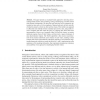Free Online Productivity Tools
i2Speak
i2Symbol
i2OCR
iTex2Img
iWeb2Print
iWeb2Shot
i2Type
iPdf2Split
iPdf2Merge
i2Bopomofo
i2Arabic
i2Style
i2Image
i2PDF
iLatex2Rtf
Sci2ools
ECCV
2010
Springer
2010
Springer
Activities as Time Series of Human Postures
Abstract. This paper presents an exemplar-based approach to detecting and localizing human actions, such as running, cycling, and swinging, in realistic videos with dynamic backgrounds. We show that such activities can be compactly represented as time series of a few snapshots of human-body parts in their most discriminative postures, relative to other activity classes. This enables our approach to efficiently store multiple diverse exemplars per activity class, and quickly retrieve exemplars that best match the query by aligning their short time-series representations. Given a set of example videos of all activity classes, we extract multiscale regions from all their frames, and then learn a sparse dictionary of most discriminative regions. The Viterbi algorithm is then used to track detections of the learned codewords across frames of each video, resulting in their compact time-series representations. Dictionary learning is cast within the largemargin framework, wherein we study the ...
Activity Classes | Computer Vision | ECCV 2010 | Multiple Diverse Exemplars | Time-series Representations |
| Added | 09 Nov 2010 |
| Updated | 09 Nov 2010 |
| Type | Conference |
| Year | 2010 |
| Where | ECCV |
| Authors | William Brendel, Sinisa Todorovic |
Comments (0)

